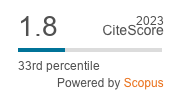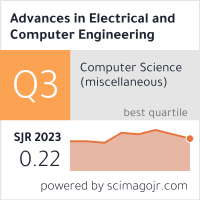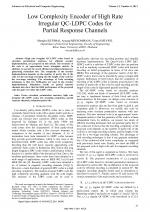| 4/2011 - 8 |
Low Complexity Encoder of High Rate Irregular QC-LDPC Codes for Partial Response ChannelsKUPIMAI, M. |
| View the paper record and citations in |
| Click to see author's profile in |
| Download PDF |
Author keywords
circulant permutation matrices, high rate irregular QC-LDPC codes, low encoding complexity, partial response channels, redundant parity bits
References keywords
codes(15), theory(7), parity(7), density(7), check(7), quasi(6), cyclic(6), shannon(4), limit(4), ldpc(4)
Blue keywords are present in both the references section and the paper title.
About this article
Date of Publication: 2011-11-30
Volume 11, Issue 4, Year 2011, On page(s): 47 - 54
ISSN: 1582-7445, e-ISSN: 1844-7600
Digital Object Identifier: 10.4316/AECE.2011.04008
Web of Science Accession Number: 000297764500008
SCOPUS ID: 84856613465
Abstract
High rate irregular QC-LDPC codes based on circulant permutation matrices, for efficient encoder implementation, are proposed in this article. The structure of the code is an approximate lower triangular matrix. In addition, we present two novel efficient encoding techniques for generating redundant bits. The complexity of the encoder implementation depends on the number of parity bits of the code for the one-stage encoding and the length of the code for the two-stage encoding. The advantage of both encoding techniques is that few XOR-gates are used in the encoder implementation. Simulation results on partial response channels also show that the BER performance of the proposed code has gain over other QC-LDPC codes. |
| References | | | Cited By «-- Click to see who has cited this paper |
| [1] R. G. Gallager, "Low density parity check codes," IRE Trans. Inf. Theory, vol.IT-8, pp.21-28, Jan. 1962. [CrossRef] [SCOPUS Times Cited 5417] [2] D. J. C. MacKay and R. M. Neal, "Good error correcting codes based on very sparse matrices," IEEE Trans. Inf. Theory, vol.45, pp. 399-431, Mar. 1999. [CrossRef] [Web of Science Times Cited 2432] [SCOPUS Times Cited 3106] [3] C. Berrou, A. Glavieux, and P. Thitimajshima, "Near Shannon limit error-correcting coding and decoding: Turbo-codes. 1," Proc. IEEE Int. Conf. on Commun., vol.2, pp.1064-1070, May 1993. [CrossRef] [4] D. J. C. Mackay and R. M. Neal, "Near Shannon limit performance of low density parity check codes," Electron. Lett., vol.32, no.18, pp.1645-1646, Aug. 1996. [CrossRef] [Web of Science Times Cited 1327] [SCOPUS Times Cited 1967] [5] T. J. Richardson, M. A. Shokrolahi, and R.L. Urbanke, "Design of capacity-approaching irregular low-density parity-check codes," IEEE Trans. Inf. Theory, vol.47, no.2, pp.619-637, Feb. 2001. [CrossRef] [Web of Science Times Cited 1978] [SCOPUS Times Cited 2382] [6] S. Y. Chung, G. D. Forney, T. J. Richardson, and R. L. Urbanke, "On the design of low density parity check codes within 0.0045 dB of the Shannon limit," IEEE Commun .Lett., vol.5, no.2, pp.58-60, Feb. 2001. [CrossRef] [Web of Science Times Cited 961] [SCOPUS Times Cited 1261] [7] L. Chen, X. Jun, I. Djurdjevic, and S. Lin, "Near-Shannon-limit quasi-cyclic low-density parity-check codes," IEEE Trans. Commun., vol.52, no.7, pp. 1038- 1042, July 2004. [CrossRef] [Web of Science Times Cited 146] [SCOPUS Times Cited 184] [8] IEEE P802.11n TM/D1.02, "Draft Amendment to Standard Information Technology Part 11: Wireless Lan Medium Access Control (MAC) and Physical Layer (PHY) specification: Enhancements for higher Throughput," IEEE 802.11 document, July 2006. [9] IEEE P 802.16eTM, "Part 16: Air Interface for Fixed and Mobile Broadband Wireless Access System," IEEE 802.16 document, Feb 2005. [10] A. Dholakia, E.Eleftheriou, T.Mittelholzer and M.P.C. Fossorier, "Capacity-aapproaching code; Can they be applied to the magnetic recording channel?," IEEE Commun. Mag., vol. 42, no. 2, pp. 122-130, Feb. 2004. [CrossRef] [Web of Science Times Cited 23] [SCOPUS Times Cited 24] [11] H. Zhong, T. Zhang and E. F. Hartsch, "Quasi-Cyclic LDPC code for the magnetic Recording Channel Code Design and VLSI Implementation," IEEE Trans. Mag., vol.43, no.3, pp. 1118-1123, March. 2007. [CrossRef] [Web of Science Times Cited 34] [SCOPUS Times Cited 40] [12] X. Liu, W. Zhang and Z. Fan, "Construct of Quasi-Cyclic LDPC Codes and the performance on the PR4 Equalizer MRC Channel," IEEE Trans. Mag., vol.45, no.10, pp. 3699-3702, Oct. 2009. [CrossRef] [Web of Science Times Cited 16] [SCOPUS Times Cited 19] [13] M. P. C. Fossorier, "Quasi-Cyclic low density parity check codes from circulant permutation matrices," IEEE Trans. Inform. Theory, vol. 50, no. 8, pp. 1788-1794, Aug. 2004. [CrossRef] [Web of Science Times Cited 845] [SCOPUS Times Cited 1111] [14] A. Sridharan, D. J. Costello-Jr., D. Sridhara, T. E. Fuja, and R.M. Tanner, "LDPC Block and Convolutional Codes Based on Circulant Matrices," IEEE Trans. Inform. Theory, vol. 50, no.12, pp. 2966-2984, Dec. 2004. [CrossRef] [Web of Science Times Cited 395] [SCOPUS Times Cited 509] [15] S. Myung, K. Yang, and J. Kim, "Quasi-Cyclic LDPC codes for fast encoding," IEEE Trans. Inform. Theory, vol. 51, pp. 2894-2901, Aug. 2005. [CrossRef] [Web of Science Times Cited 185] [SCOPUS Times Cited 268] [16] Z. Li., L. Chen, L. Zeng, S. Lin, and W. H. Fong, "Efficient encoding of quasi-cyclic low density parity-check codes," IEEE Trans. Commun., vol. 54, no.1, pp. 71-81, Jan. 2006. [CrossRef] [Web of Science Times Cited 312] [SCOPUS Times Cited 414] [17] D. J. C. Mackay and M. Davey, "Evaluation of Gallager codes for short block length and high rate applications," in Proc. IMA Workshop Codes, System-Margulis and Graphical Models, 1999. [18] R. M. Tanner, "A Recursive Approach to Low Complexity Codes," IEEE Trans. Inform. Theory, vol. 27, pp. 533-547, Sep. 1981. [CrossRef] [Web of Science Times Cited 1838] [SCOPUS Times Cited 2345] [19] J. Hagenuer and P. Hoecher, "A Viterbi algorithm with soft decision output and its application," in Proc. IEEE GLOBECOM, pp. 47.11-47, Dallas, TX, Nov. 1989. [CrossRef] Web of Science® Citations for all references: 10,492 TCR SCOPUS® Citations for all references: 19,047 TCR Web of Science® Average Citations per reference: 552 ACR SCOPUS® Average Citations per reference: 1,002 ACR TCR = Total Citations for References / ACR = Average Citations per Reference We introduced in 2010 - for the first time in scientific publishing, the term "References Weight", as a quantitative indication of the quality ... Read more Citations for references updated on 2024-07-22 10:25 in 114 seconds. Note1: Web of Science® is a registered trademark of Clarivate Analytics. Note2: SCOPUS® is a registered trademark of Elsevier B.V. Disclaimer: All queries to the respective databases were made by using the DOI record of every reference (where available). Due to technical problems beyond our control, the information is not always accurate. Please use the CrossRef link to visit the respective publisher site. |
Faculty of Electrical Engineering and Computer Science
Stefan cel Mare University of Suceava, Romania
All rights reserved: Advances in Electrical and Computer Engineering is a registered trademark of the Stefan cel Mare University of Suceava. No part of this publication may be reproduced, stored in a retrieval system, photocopied, recorded or archived, without the written permission from the Editor. When authors submit their papers for publication, they agree that the copyright for their article be transferred to the Faculty of Electrical Engineering and Computer Science, Stefan cel Mare University of Suceava, Romania, if and only if the articles are accepted for publication. The copyright covers the exclusive rights to reproduce and distribute the article, including reprints and translations.
Permission for other use: The copyright owner's consent does not extend to copying for general distribution, for promotion, for creating new works, or for resale. Specific written permission must be obtained from the Editor for such copying. Direct linking to files hosted on this website is strictly prohibited.
Disclaimer: Whilst every effort is made by the publishers and editorial board to see that no inaccurate or misleading data, opinions or statements appear in this journal, they wish to make it clear that all information and opinions formulated in the articles, as well as linguistic accuracy, are the sole responsibility of the author.





